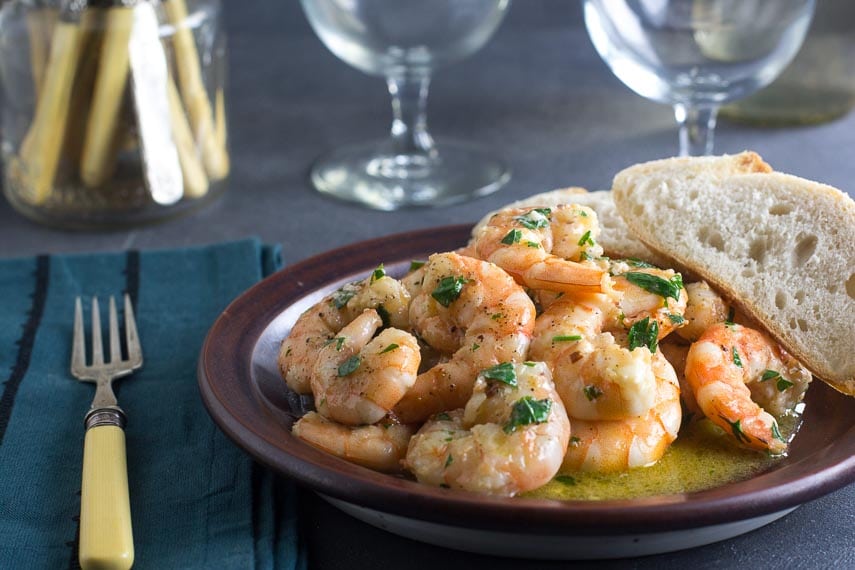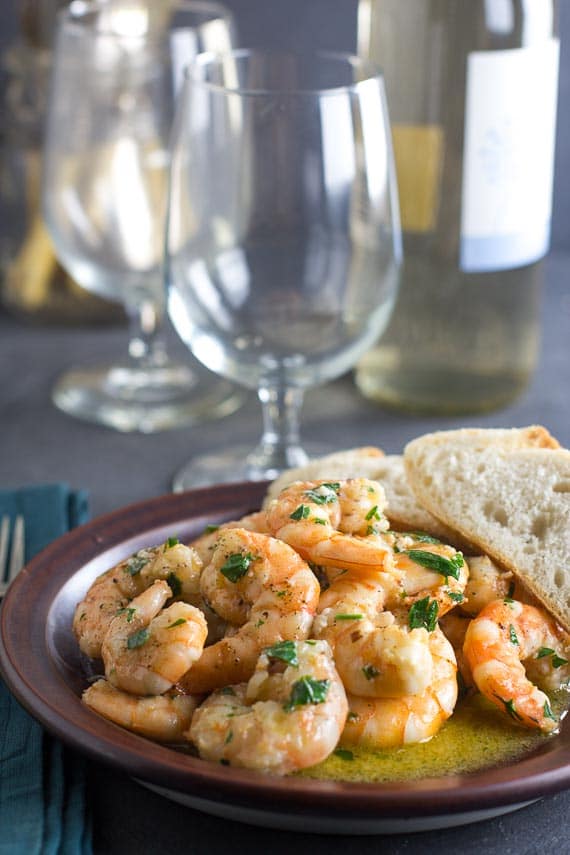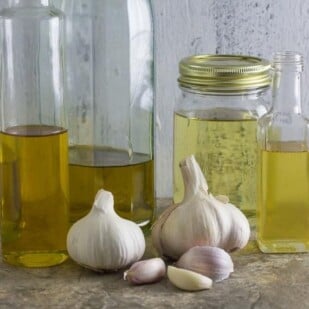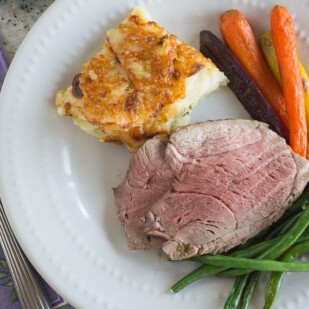Our Low FODMAP Scampi is just as garlicky and buttery as the classic recipe you used to enjoy – but using low FODMAP ingredients. We waited to make this dish until we could make it as garlicky as necessary. After all, when we think scampi, we think shrimp, garlic and butter. Thanks to FreeFod Garlic Replacer the garlic flavor we were looking for is finally possible.
FreeFod Garlic Replacer
If you are not familiar with this product, we encourage you to do so, and its sister product, FreeFod Onion Replacer. They are powdered products that can be used in very similar ways to garlic powder and onion powder and their flavors pack a wallop!
The garlic replacer is exactly what we needed to make low FODMAP scampi to taste like the scampi you used to enjoy, pre-FODMAP.
Please do not make this dish without it. You could try just using the Garlic-Infused Oil, and if you make your own with our recipe you can even make it double the strength (by doubling the garlic) but it will still not have the garlic flavor you are looking for in a scampi dish.
What Is Scampi, Anyway?
There is some confusion over the term “scampi”, as it can refer to a recipe with certain flavors and ingredients, or it can refer to a particular group of marine crustaceans. To make things more confusing, these two things do not necessarily appear together. Let me explain.
Location, Location, Location
The term “scampi” can mean different things, depending on whether you like in Italy, the U.S. or the UK (or elsewhere, presumably).
In the U.S. we think of preparation and it usually means shrimp, bathed in garlic and butter, sometimes with some white wine added to make it saucy. and often served with spaghetti. It is an Italian American dish, first becoming popular in the 1970s – but deserves a re-boot, FODMAP style. Our Low FODMAP Scampi is along these lines.
In the UK scampi is legally defined specifically as Nephrops norvegicus, also known as Norway lobster, Dublin Bay prawn, or langoustine and is a type of lobster, not a shrimp. This species is native to the Atlantic waters of the EU, from the Azores to the North Sea. It is also fished in the Adriatic, although it is not common in the Mediterranean. It reaches a maximum total length of 10-inches (25 cm), which includes the tail and clawed legs.
In the UK you might find just the tail meat, and this would be called “scampi tails”. In this area of the world the crustacean is often prepared breaded or battered and fried. It can also be sold as “scampi bites” or “formed scampi” or some other moniker, which should be a red flag. In these you might find breadcrumbs being the predominant ingredient, then inexpensive cod and the actual scampi a minority ingredient.
Shrimp Sizes
Ah, shrimp sizes. Just like canned olives a lot of superlative words are used like jumbo and colossal and even extra jumbo and extra colossal. It’s enough to make one’s head spin especially since the terms used at your supermarket are NOT regulated. In other words, one fishmongers “large” shrimp might be different from the “large” shrimp for sale down the street.
This is why it is more important to pay attention to the numbers – as in jumbo 21/25. What this means is that this particular pile of shrimp you are looking at is being referred to as “jumbo” and there are 21 to 25 of the shrimp per pound. It is that per pound number that will most accurately guide you.
Our shrimp recipes will tell you the count per pound (when necessary, which it almost always is). This is important for how the shrimp cook and also for the ultimate yield of the recipe. Pay attention to count!
Numbers Over Size
Here is a chart of shrimp sizes, with the most common terms used and accompanying counts per pound. Again, names like “jumbo” and “extra-large” do not mean anything consistent from store to store, or packaged brand to packaged brand. Go by the numbers and buy what your shrimp recipes call for.
| Descriptive Labeling | Shrimp Count per Pound | Average Shrimp per Pound |
| (“U” means “under”) | ||
| Extra Colossal | U10 | 5 |
| Colossal | U12 | 9 |
| Colossal | U15 | 14 |
| Extra Jumbo | 16/20 | 18 |
| Jumbo | 21/25 | 23 |
| Extra Large | 26/30 | 28 |
| Large | 31/35 | 33 |
| Medium Large | 36/40 | 38 |
| Medium | 41/50 | 45 |
| Small | 51/60 | 55 |
| Extra Small | 61/70 | 65 |
If you want to learn more about shrimp, perhaps even more than you ever wanted, this document from Seafood Health Facts is thorough.
For this recipe please find shrimp that weigh 26 to 30 per pound, often called “extra-large”. This will average about 28 shrimp per pound, you are using 1 ½-pounds, which means you will have about 42 shrimp. This divides (almost) nicely into our 4 servings.
Tails On, Tails Off
My husband – and I know several people like him – want their shrimp dishes naked. That is, they want the shrimp completely peeled; no shell at all. All the better to get the shrimp into your mouth to eat as easily as possible.
There are four basic ways to present your shrimp:
- Completely peeled
- Tail on
- Tail and body shell intact
- With tail, body and head intact
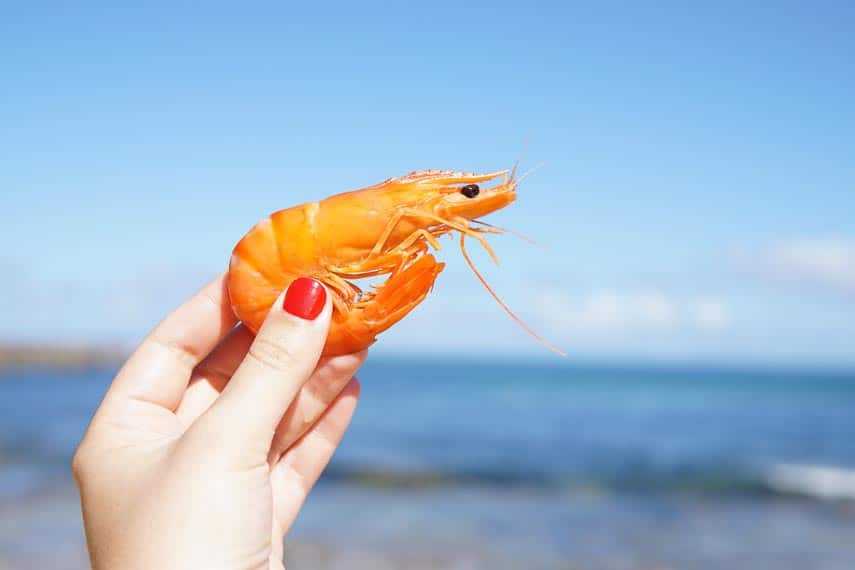
Pros & Cons
Here’s the deal: the tail, body shell and head add an immense amount of flavor. But you have to balance how easy you want to make it for diners at the table vs. maximum flavor extraction, plus, for many people finding the shrimp with heads intact isn’t possible.
The point is, that you can choose whatever shrimp presentation you like. The cooking will be the same – just a tad longer with the shells. If you do cook with shell on, make sure to offer a discard bowl for everyone’s shells. You can put them to the side on your own plate, of course, but it is a nice touch to offer an additional receptacle.
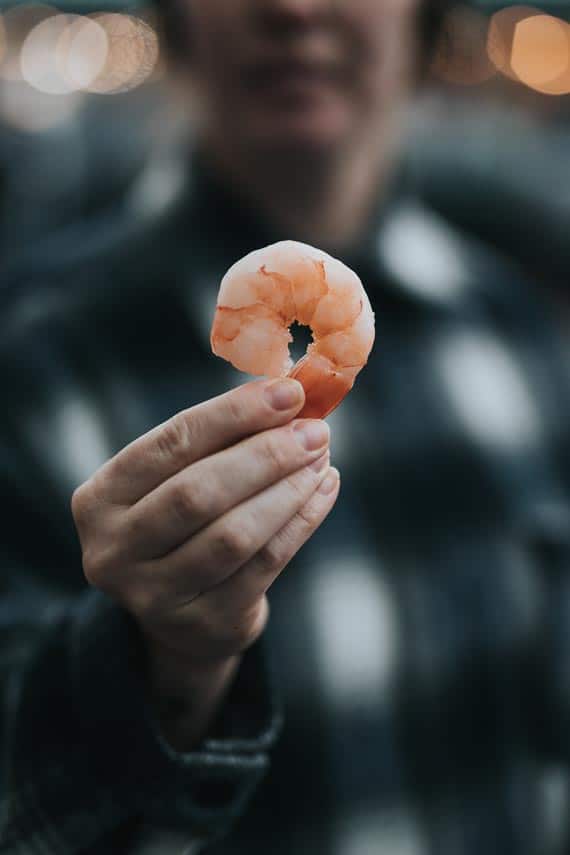
Buy With Shell, Then Peel
Then, there is also the fact that you could buy the shrimp with shells intact and peel them yourself before cooking. If you do this, there is an extra step you can take that will boost the shrimpy flavor: peel your shrimp and combine with the wine. Bring to a boil, then turn off the heat and let sit for 15 minutes, then strain, discarding the shells. Now you can use the wine as described in the recipe; your wine will be infused with shrimp flavor.
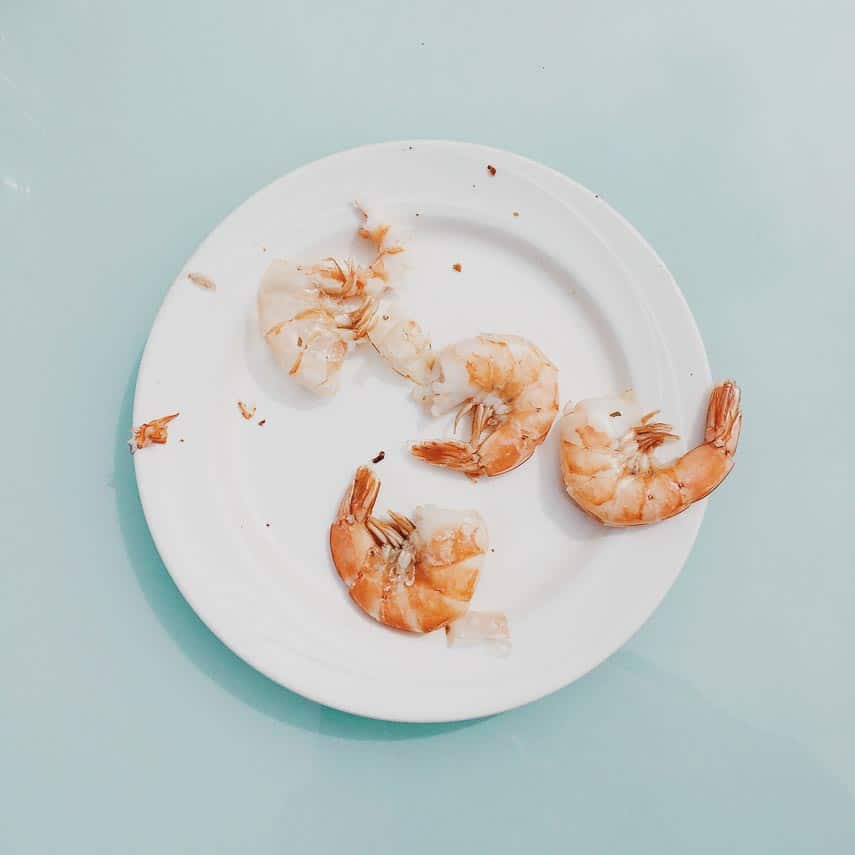
More Low FODMAP Shrimp Dishes
- Shrimp Fra Diavolo
- Shrimp & Grits
- Pickled Shrimp
- Spicy Sichuan Shrimp & Noodles
- Sautéed Shrimp
- Shrimp & Corn Chowder
- Hot & Sour shrimp Lo Mein
- Shrimp & Broccoli
- Buffalo Shrimp
- Roasted Shrimp
- Shrimp & Chicken Congee
- Pad Thai
- Shrimp Tacos
Want more quick and easy dinners? Check out our article, Easy Peasy Dinner and Dessert: 20 One-Pan, One Bowl Low FODMAP Recipes for Busy Nights.
Let’s Make Low FODMAP Scampi!
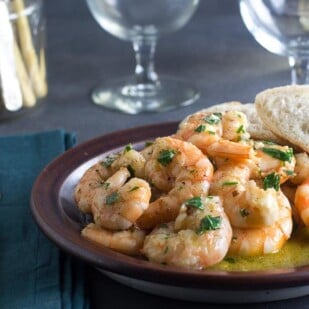
Low FODMAP Scampi
Our Low FODMAP Scampi is just as garlicky and buttery as the classic recipe you used to enjoy – but using low FODMAP ingredients. We waited to make this dish until we could make it as garlicky as necessary. After all, when we think scampi, we think shrimp, garlic and butter. Thanks to FreeFod Garlic Replacer the garlic flavor we were looking for is finally possible.
Ingredients:
- ½ cup (120 ml) dry white wine
- 1 teaspoon FreeFod Garlic Replacer
- 2 tablespoons unsalted butter
- 2 tablespoons Garlic-Infused Oil, made with olive oil, or purchased equivalent
- ½ teaspoon kosher salt
- Freshly ground black pepper
- Pinch red pepper flakes; optional
- 1 ½- pounds (680 g) extra-large shrimp, 26 to 30 count per pound, deveined; peeled or shells intact
- ¼ cup (8 g) chopped flat-leaf parsley
- ½ whole lemon, cut into wedges
- Low FODMAP Baguette
Preparation:
-
Whisk the wine and the FreeFod Garlic Replacer together in measuring cup until solids dissolve; set aside.
-
Melt butter and oil in a large skillet over low-medium heat then whisk in salt, black pepper to taste and the red pepper, if using, and sauté for a few seconds. Add the wine, bring to a simmer and cook for about 2 minutes or until it reduces by almost half.
-
Add shrimp and toss around “just” until they turn pink, which will only take a minute, or two or three, depending on their size. Do NOT overcook or you will be left with garlicky, rubbery, chewy shrimp. I usually stop short about 30-seconds of being fully cooked, as there is residual pan heat. Remove from heat, squeeze lemon juice over, sprinkle with parsley and toss again, then get them on a warmed plate and serve with slices of low FODMAP baguette for sopping up the sauce.
Notes:
Tips
• You can serve this over pasta. We like rice-based spaghetti the best. Cook 12-ounces (340 g) of low FODMAP pasta until al dente, reserving some pasta water. Drain pasta then add to pan with shrimp. Toss well while over low heat, adding some pasta water to create a sauce that coats the pasta. Serve immediately.
FODMAP Information
Our recipes are based on Monash University and FODMAP Friendly science.
- Butter: Both Monash University and FODMAP Friendly have lab tested butter. Monash states that a low FODMAP Green Light portion is 1 tablespoon or 19 g and also states that “butter is high in fat and does not contain carbohydrates (FODMAPs)”. FODMAP Friendly gives it a “Pass” at 1 tablespoon or 19 g. Both recommended serving sizes are presented as part of healthy eating guidelines, not as maximum FODMAP serving size. Fat can affect guy motility and trigger IBS symptoms in some people. Eat to your tolerance.
- Garlic-Infused Oil: Make your own Garlic-Infused Oil or buy a commercial equivalent for the easiest way to add garlic flavor to your food. Fructans in garlic are not oil-soluble, so garlic-infused oil is low FODMAP.
- Wine: Red, white and sparkling wine is low FODMAP in 150 ml portions as determined by Monash University and FODMAP Friendly lab testing.
Please always refer to the Monash University & FODMAP Friendly smartphone apps for the most up-to-date lab tested information. As always, your tolerance is what counts; please eat accordingly. The ultimate goal of the low FODMAP diet is to eat as broadly as possible, without triggering symptoms, for the healthiest microbiome.
Nutrition
All nutritional information is based on third-party calculations and should be considered estimates. Actual nutritional content will vary with brands used, measuring methods, portion sizes and more. For a more detailed explanation, please read our article Understanding The Nutrition Panel Within Our Recipes.
